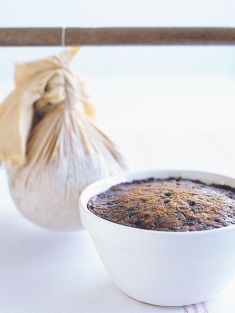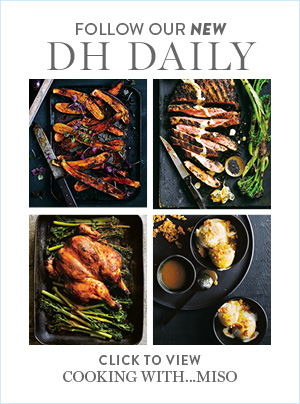cloth-wrapped Christmas pudding

- 150g sultanas
- 150g currants
- 1⅔ cups (250g) raisins, halved
- 150g pitted dates or prunes, chopped
- 125g candied peel
- ½ cup brandy or sherry
- 250g butter
- ¼ cup (45g) brown sugar
- ¼ cup (55g) white sugar
- 3 eggs
- 85g slivered almonds
- 1 cup (150g) plain (all-purpose) flour
- 1 teaspoon ground cinnamon
- 1 teaspoon mixed spice
- 250g breadcrumbs
- 150ml milk
- Place the sultanas, currants, raisins, dates, peel and brandy in a large bowl and allow to soak for at least 4 hours or overnight.
- Beat the butter and brown and white sugar in an electric mixer until light and creamy. Add eggs and beat well. Place the butter mixture in a large bowl along with the sultana mixture, almonds, flour, cinnamon, mixed spice, breadcrumbs and milk. Mix until well combined.
- Place pudding mixture in the middle of your prepared piece of calico* and gather up the ends. Tie tightly with string as close to the pudding as possible, making a loop at the end for hanging. Immerse pudding in a large saucepan of boiling water and boil for 4½ hours. Remove pudding from pan (wear rubber gloves to protect your hands) and hang over a sink or bucket on a broomstick so it hangs freely. Allow to dry and cool. Store in the fridge for up to 2 months.**
- To reheat, immerse pudding in a saucepan of boiling water and boil for 45 minutes. Allow to drain for 5 minutes before unwrapping.*** Serve with warm brandy custard. Serves 6–8.
* You will need an 80cm-square piece of calico. Rinse it under hot water to remove the starch. Wearing rubber gloves, dip it into boiling water, then wring out. Place ½ cup (125g) plain (all-purpose) flour in the centre of the cloth. Rub in a circular motion to spread in a thin layer about 50cm diameter.
** To prevent the cloth-wrapped pudding from going mouldy due to humidity, wrap it loosely in a tea towel and keep it in the vegetable crisper of the fridge.
*** You will will know the pudding is hot enough, if the cloth comes away easily.
Caroline Varendorff
The really important thing is the wrapping in calico procedure. I followed these instructions but the pudding(s) stuck to the cloth when I tried to unwrap them. I think it’s important to rub the flour into the cloth while the cloth is still hot from the boiling water so rubber gloves are a must. This means that the flour will stick more to the cloth and form a more protective film between the pudding and the boiling water that it is immersed into. I usually do my puddings in a pudding basin but this year I wanted to make 6 smaller puddings to give as gifts, and didn’t have 6 small pudding bowls so this ‘in the cloth’ method seemed like a perfect solution, however I’m now trying to scrape damp pudding mixture off the calico, reshape the puddings and wrap them again in a presentable way!






